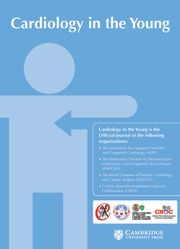No CrossRef data available.
Article contents
Positive impact of an inpatient early childhood literacy programme on literacy practices and family experience in a paediatric heart centre
Published online by Cambridge University Press: 23 October 2024
Abstract
CHD predisposes children to neurodevelopmental delays. Frequent, prolonged hospitalisations during infancy prevent children with heart disease from participating in recommended language and cognitive development programmes, such as outpatient early childhood literacy programmes, and contribute to caregiver stress, a risk factor for adverse developmental outcomes. This study aims to describe the implementation of a single-centre inpatient early childhood literacy programme for hospitalised infants with heart disease and assess its impact on reading practices and patient–family hospital experience.
Admitted infants ≤1 year old receive books, a calendar to track reading frequency, and reading guidance at regular intervals. Voluntary feedback is solicited from caregivers using an anonymous, QR-code survey on books. A prospective survey also assessed programme impact on hospital experience.
From February 2021 to November 2023, the Books@Heart programme provided 1,293 books to families of 840 infants, of whom 110 voluntarily submitted feedback. Caregivers reported a significant improvement in access to books (p < 0.001) and increased reading frequency after learning about Books@Heart (p = 0.003), with the proportion reading to their child daily increasing from 27% to 62%. Among 40 prospective survey responses, caregivers reported feeling a sense of personal fulfillment (60%), self-confidence (30%), connection (98%), and personal well-being (40%) while reading to their child.
An inpatient early childhood literacy programme is a well-received intervention for infants with heart disease that promotes development, improves book access, increases reading exposure, and engages families. Further studies are needed to assess its impact on sustained reading practices and neurodevelopmental outcomes.
- Type
- Original Article
- Information
- Copyright
- © The Author(s), 2024. Published by Cambridge University Press



